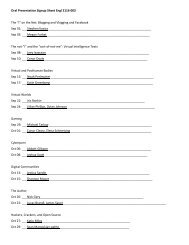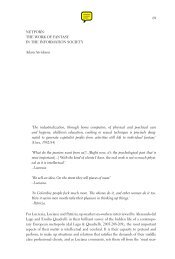Nakamura, Digitizing Race, Introduction, chapter 5, Epilogue
Nakamura, Digitizing Race, Introduction, chapter 5, Epilogue
Nakamura, Digitizing Race, Introduction, chapter 5, Epilogue
Create successful ePaper yourself
Turn your PDF publications into a flip-book with our unique Google optimized e-Paper software.
Alllooksame? 89<br />
popular culture has been defined by film. There is a tradition in India to<br />
interpret society through film.” As the Internet becomes richer in moving<br />
images, it may have more to offer users whose cultural vernacular encompasses<br />
video and signboards, visual cultures of movement and signification,<br />
rather than text.<br />
Shuddhabrata Sengupta, a filmmaker and media practitioner who is also<br />
a member of the Raqs Media Collective and a founder of the Sarai New<br />
Media Centre in Delhi, articulates some of the complexities of cultural<br />
negotiation regarding new media forms in the postcolonial context. In his<br />
discussion of the practicalities of using Hindi as an Internet language, he<br />
weighs on the one hand the imperatives of “cultural authenticity”—that is,<br />
retaining the Hindi character set despite its incompatibilities with existing<br />
hardware—against the loss suffered by having to translate Hindi to the<br />
Roman character set, which cannot accommodate Hindi without expensive<br />
equipment that makes the translation cost-prohibitive in a country where<br />
any network connection is already a precious commodity. Sengupta’s solution<br />
is that Indians must give up the typographical “purity” of Hindi to<br />
enter the digital commons. Questions of the postcolonial politics of translation<br />
and language are foremost in Sengupta’s argument. He writes that<br />
though “the sense of inauthenticity accompanying this stance may produce<br />
some discomfort, it at least brings with it a means of entering the digital<br />
commons on reasonably fair terms. Once there, we are free to forage for new<br />
meanings and new identities.” The discourse of “purity” is here weighed<br />
against the appeal of the “digital commons” and found wanting. The desire<br />
for cultural purity implies a drive to keep unproblematic notions of race,<br />
identity, gender, and other subject positions untainted by cultural hybridity<br />
in any form, from either new media or old. Sengupta is willing to trade a<br />
“pure” Internet Hindi for the opportunity to use new media to forge “new<br />
meanings and new identities,” which will necessarily be hybrid in nature.<br />
Thus, despite their many ideological differences, both Sardar and the<br />
Sarai founders seem to agree that the Internet will produce “impure” or “inauthentic”<br />
expressive forms. Where they differ is in the question of whether<br />
this is a trade worth making and whether it is pragmatic to resist it.<br />
Of course, these are not the only two “postcolonial” positions vis-à-vis<br />
the Internet; postcolonial theory is far too complex to produce only two<br />
modes of interpretation on this or any subject. To sum it up, however, critics<br />
like Sardar are concerned primarily with preserving cultural authenticity<br />
and see the medium of cyberspace itself as a vector for Western ideologies,





